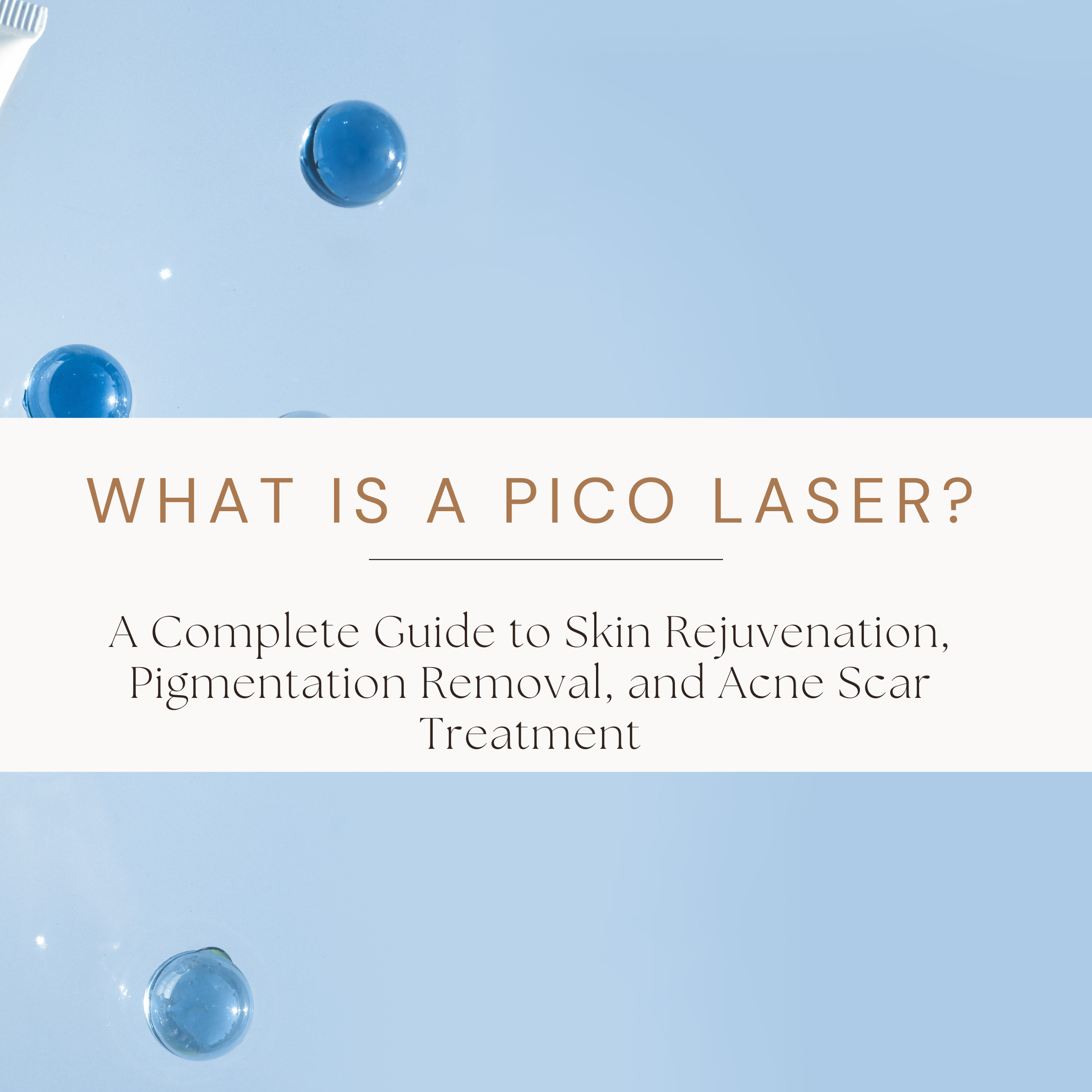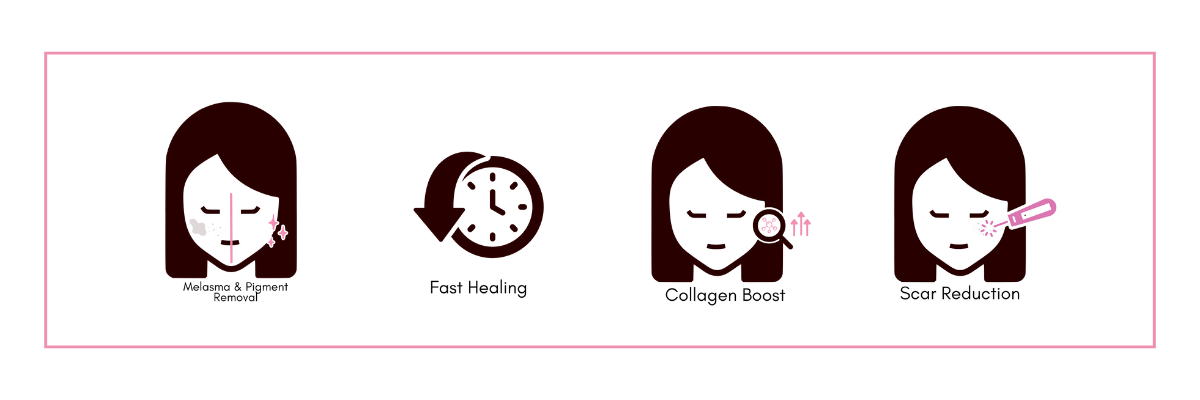
What is a Pico Laser? A Complete Guide to Skin Rejuvenation, Pigmentation Removal, and Acne Scar Treatment
Clear, even-toned skin is something many people hope for, especially when concerns like pigmentation, acne scars, or unwanted tattoos start to affect confidence. Pico Laser is a gentle yet powerful treatment that helps the skin look fresher, smoother, and more radiant by supporting its natural renewal process. If you’ve been wondering whether this treatment could be the right solution for your skin needs, here’s a complete guide to help you understand how Pico Laser works and what to expect.
What is Pico Laser?
Pico Laser is a modern laser treatment that uses extremely short bursts of light energy, measured in picoseconds, which is one trillionth of a second. These rapid pulses target unwanted pigments in the skin or tattoo ink, breaking them into tiny fragments that the body can naturally clear away.
Because of its unique technology, Pico Laser works without generating excessive heat. This makes it gentler on surrounding skin, reducing the risk of damage while still achieving effective results. It is commonly used for tattoo removal, stubborn pigmentation, melasma, freckles, and even acne scars.
Expert Insight
“Thanks to its rapid speed, skin damage is minimized and recovery after treatment is quick. PicoSure, approved by the U.S. FDA and Korea KFDA, provides effective results regardless of the pigment’s color, size, or depth.”
— My Future Dermatology Clinic, Yeouido

Benefits of Pico Laser
1. The technology is gentle on the skin, as it targets only the unwanted pigment while leaving surrounding healthy tissue unharmed.
2. Pico Laser provides more effective pigment clearance because it breaks down tattoo ink and skin pigmentation more efficiently than traditional Q-switched lasers.
3. It often requires fewer treatment sessions, which means you can achieve results with less time and lower overall cost.
4. The technology is gentle on the skin, as it targets only the unwanted pigment while leaving surrounding healthy tissue unharmed.
5. Downtime is minimal, with redness or mild swelling usually settling within just a few days.
6. Pico Laser is highly versatile, making it suitable for treating pigmentation, acne scars, sun damage, fine lines, and unwanted tattoos.
Risks and Side Effects of Pico Laser
Pico Laser is generally safe and well tolerated, but like any skin treatment, it may cause some short-term side effects. These can include temporary redness, swelling, or mild crusting in the treated areas. Most of these reactions are mild and fade naturally within a few days.
Because results and risks depend on skin type, treatment settings, and the skill of the provider, it is important to work with a qualified dermatologist or laser specialist. This ensures your treatment is tailored to your skin’s needs and minimizes the chance of unwanted pigmentation changes or scarring.
Is Pico Laser Right for You?
Pico Laser is designed to help people who want visible improvements without the need for surgery or long recovery times. It works best for those who are focused on clearing pigmentation, fading tattoos, or achieving smoother, healthier-looking skin.
Since every skin is different, starting with an AI Skin Analysis can help you understand your skin type first and see if Pico Laser is the best fit for your needs.
Ideal Candidates
Pico Laser may be a good choice if you:
→ Struggle with melasma, freckles, sunspots, or other pigmentation issues
→ Have acne scars or uneven skin texture you want to improve
→ Prefer a non-invasive treatment with minimal downtime
→ Are looking for a safe way to refresh skin and restore clarity
→ Want to remove tattoos, including resistant colors such as green or blue
Pico Laser for Your LuluTI Skin Type: Who Sees the Best Results
Pico Laser is great for people with pigmentation issues, freckles, dark spots and uneven skin tone. Its rapid, gentle pulses target unwanted pigment and break it down so the body can naturally clear it away. It also has additional benefits for skin texture and pore refinement, especially with Pico Fractional Mode.
From LuluTI's perspective, Pico Laser is most beneficial for skin types with a “P” (Pigmentation) profile. With its fractional mode, it may also offer additional improvements for “T” (Texture/ores) profiles, though these effects are secondary and generally less pronounced.
Best Matches: WATP, WASP, WUTP, WUSP, EATP, EASP, EUTP, EUSP
Also Beneficial: WATC, WUTC, EATC, EUTC.
To find out if Pico Laser is right for you, get a Lululab AI Skin Analysis. It will give you a clear understanding of your skin condition and help you find the best treatment for you.
Types of Pico Lasers: How They Work and What They Do
There are several Pico Laser devices available today. While they all use picosecond pulse technology, the difference lies in their wavelength and design, which makes them better suited for specific skin concerns or tattoo colors.
Pico Laser Type | Wavelength(s) | Best For | How It Works |
|---|---|---|---|
PicoSure® | 755 nm (Alexandrite), 532 nm | Pigmentation, freckles, acne scars, skin texture | Delivers ultra-short bursts of energy to break down pigments and boost collagen |
PicoWay® | 532 nm, 730 nm, 785 nm, 1064 nm | Melasma, freckles, age spots, skin rejuvenation | Multiple wavelengths allow precise targeting of different pigmentation issues |
Discovery Pico® | 532 nm, 1064 nm, 694 nm | Stubborn pigmentation, melasma, skin resurfacing | Combines the photoacoustic effect (light energy converted into sound waves to shatter pigment without heat damage) with fractional handpieces for both pigment and skin texture improvement |
Enlighten™ | 532 nm, 1064 nm | Pigmentation, acne scars, overall skin rejuvenation | Dual-pulse technology (picosecond + nanosecond) gives flexibility for stubborn tattoos and skin treatments |
All types work by breaking pigment into tiny particles while protecting surrounding skin, leading to faster clearance and minimal downtime.
What to Expect: Timeline and Results After Pico Laser
▶ Right after treatment:
Your skin may appear red and slightly swollen, similar to a mild sunburn. This reaction is temporary and usually settles within a few hours to a day. Some people also notice frosting or light whitening of tattoo ink, which is a normal sign that the pigment has absorbed the laser energy.
▶ First week:
As your skin begins to repair, light crusting or micro-scabs may appear where pigment is breaking down. These flakes shed naturally over several days, revealing fresher skin underneath. Keeping the area moisturized and avoiding picking helps the skin heal smoothly and reduces the risk of marks or irritation.
▶ 1 to 2 weeks:
By this stage, you may see early fading of pigmentation or tattoo ink along with an overall brighter, more even tone. The skin often feels smoother and softer, especially if scarring or texture was treated. Any lingering pinkness usually improves, and many people feel comfortable resuming their normal skincare routine.
▶ Multiple sessions:
Deeper pigmentation and tattoos typically need several treatments spaced 4 to 8 weeks apart. With each session, the pigment particles continue to break down and fade, and the skin becomes progressively clearer. The gradual pace allows safe healing while giving your body time to naturally clear the treated pigment.
▶ Ongoing improvement:
Over the following weeks and months, collagen stimulation helps refine skin texture and support long-term improvements. Scars and fin
Aftercare: Tips for the Best Pico Laser Results
Proper aftercare is essential to maximize your Pico Laser results, support healing, and keep your skin looking its healthiest
Protect your skin from the sun: It’s important to apply a generous amount of sunscreen daily to prevent pigmentation from returning.
Keep the treated area clean and moisturized: Gentle cleansing and hydration support the skin’s healing process while reducing dryness, irritation, or flaking.
Avoid touching or picking at the skin: Scratching, peeling, or picking at scabs can increase the risk of infection, scarring, and delayed recovery.
Pause harsh skincare products: Hold off on exfoliants, scrubs, or retinoids for at least one week to avoid unnecessary irritation while your skin heals.
Follow your dermatologist’s advice: Every skin type responds differently, so personalized instructions from your provider will help you achieve the best outcome.
Pico Laser vs Q-Switched Laser: Which Treatment Is Best for You?
Pico Laser
Pico Laser uses ultra-fast picosecond pulses to break pigment into tiny particles. It is gentler on the skin, requires fewer sessions, and has minimal downtime. It works well for stubborn pigmentation, acne scars, melasma, freckles, and multicolored tattoos.
Q-Switched Laser
Q-Switched Laser uses nanosecond pulses and relies more on heat. While effective for pigmentation and tattoos, it often needs more sessions, has longer recovery time, and may cause more redness or darkening after treatment.
In summary, choose Pico Laser if you want faster, gentler, and more precise results with less downtime. Opt for Q-Switched Laser if you prefer a more established, widely available, and often more affordable treatment option.
Next Steps for your Pico Laser journey
If you are considering Pico Laser, book a consultation with a dermatologist or certified laser specialist. They will assess your skin type, discuss your goals, and guide you toward the treatment that will give you the safest and most effective results.
Pico Laser FAQs: Everything You Need to Know Before Starting
1. How many sessions will I need?
Tattoo removal may take 4 to 8 sessions, while pigmentation issues often improve after 2 to 4 treatments.
2. Is Pico Laser painful?
Most people describe it as a quick snapping sensation. Numbing cream can make the treatment more comfortable.
3. How long does each session take?
Treatment usually takes 15 to 30 minutes, depending on the area.
4. Can Pico Laser treat all tattoo colors?
Yes, it is especially effective for stubborn colors such as green, blue, red, and yellow.
5. When will I see results?
You may notice fading after the first session, but optimal results appear after completing the recommended series of treatments.

